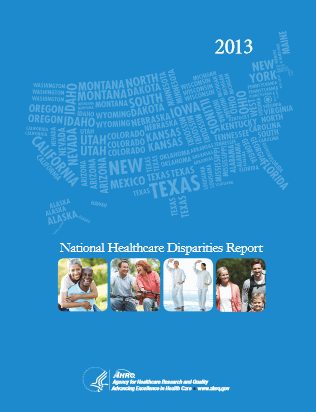Health Disparities in US
 |
|---|
What are Health Disparities?
| A health disparity is a particular type of health difference that is closely linked with social, economic, and/or environmental disadvantage. Racial and ethnic minorities still lag behind in many health outcome measures. They are less likely to get the preventive care they need to stay healthy, more likely to suffer from serious illnesses, such as diabetes or heart disease, and when they do get sick, are less likely to have access to quality health care. Disparities are documented in many conditions, including: cardiovascular disease, asthma, diabetes, flu, infant mortality, cancer, HIV/AIDS, chronic lower respiratory diseases, viral hepatitis, chronic liver disease and cirrhosis, kidney disease, injury deaths, violence, behavioral health, and oral health. (Fact Sheet: The HHS Action Plan to Reduce Racial and Ethnic Health Disparities.)
From the HHS Action Plan to Reduce Racial and Ethnic Health Disparities, 2011 |
As an introduction to the week, watch this short video on health equity from the Association of American Medical Colleges.
|
Living in Disadvantaged Neighborhoods is Bad for Your Health |
Each year the Agency for Healthcare Research and Quality (AHRQ) reports on the opportunities for improving health care quality and reducing health care disparities in the United States. Based on the latest data, reports show health care quality continues to improve—but health care disparities persist for many of America's minorities and the poor. As AHRQ Director Dr. Carolyn Clancy explains, "These reports show that health care quality in the US is continuing to improve, but at a very slow rate and that, generally, inequalities in health care are not improving. We need to ramp up our overall efforts to improve health care quality and focus specific attention on areas that need the greatest improvement so that all Americans have access to high-quality, appropriate, and safe health care."
|

|
The National Health Disparities Report
The National Health Disparities Report for 2013 (May 2014) presents the nation's priorities and action plans to reduce health disparities among racial and ethnic minorities. The plan reflects provisions of the ACA and HP 2020 goals.
|
AHRQ's priority populations, specified by Congress in the Healthcare Research and Quality Act of 1999 (Public Law 106-129), are:
- Racial and ethnic minority groups
- Low-income groups
- Women
- Children (under age 18)
- Older adults (age 65 and over)
- Residents of rural areas
- Individuals with special health care needs, including individuals with disabilities and individuals who need chronic care or end-of-life care
Other populations, such as LGBT (lesbian, gay, bisexual and transgender persons) and those with multiple chronic medical conditions (MCC), are also included.
Predisposing, Enabling, and Need Characteristics of Vulnerability
|
|
|
